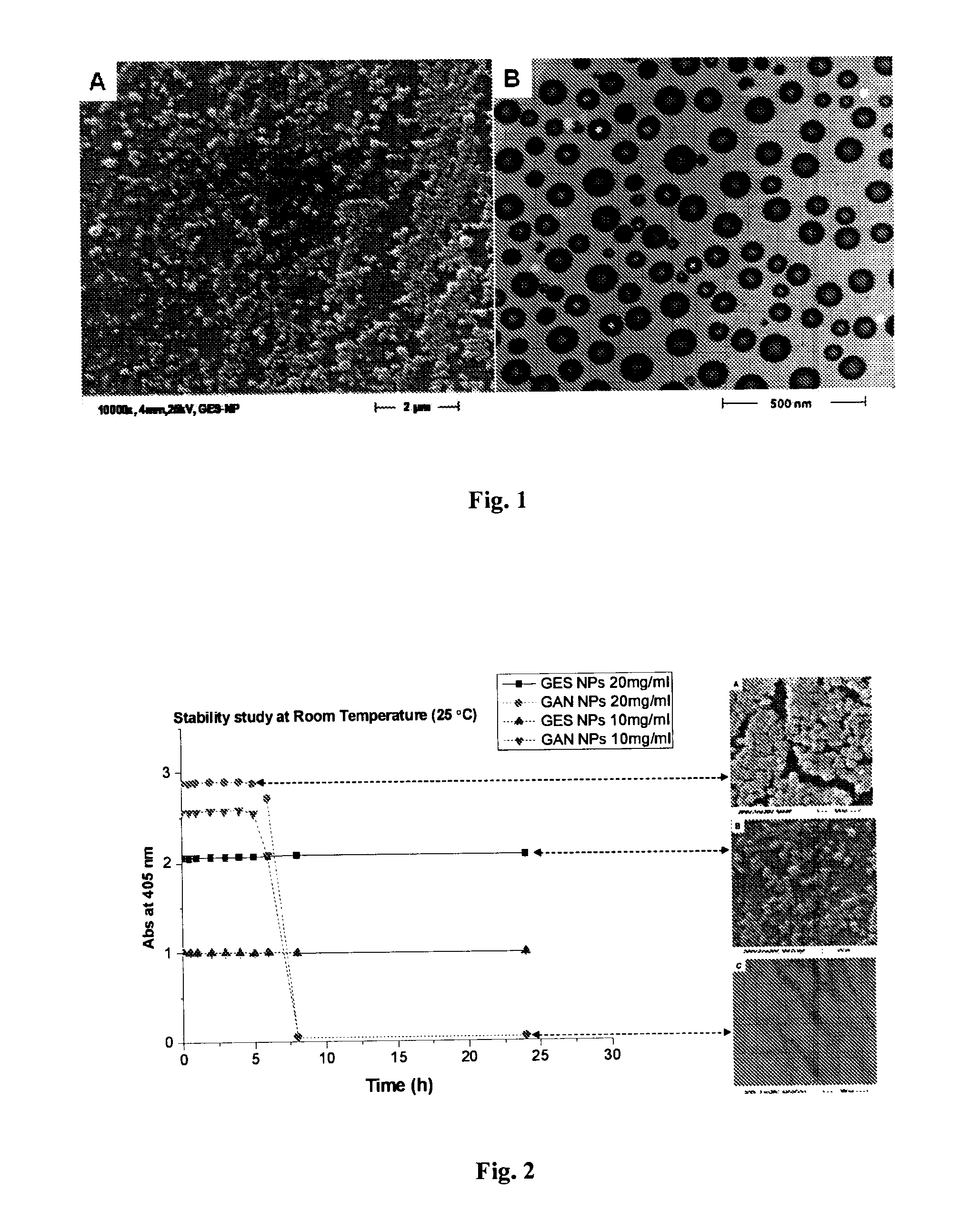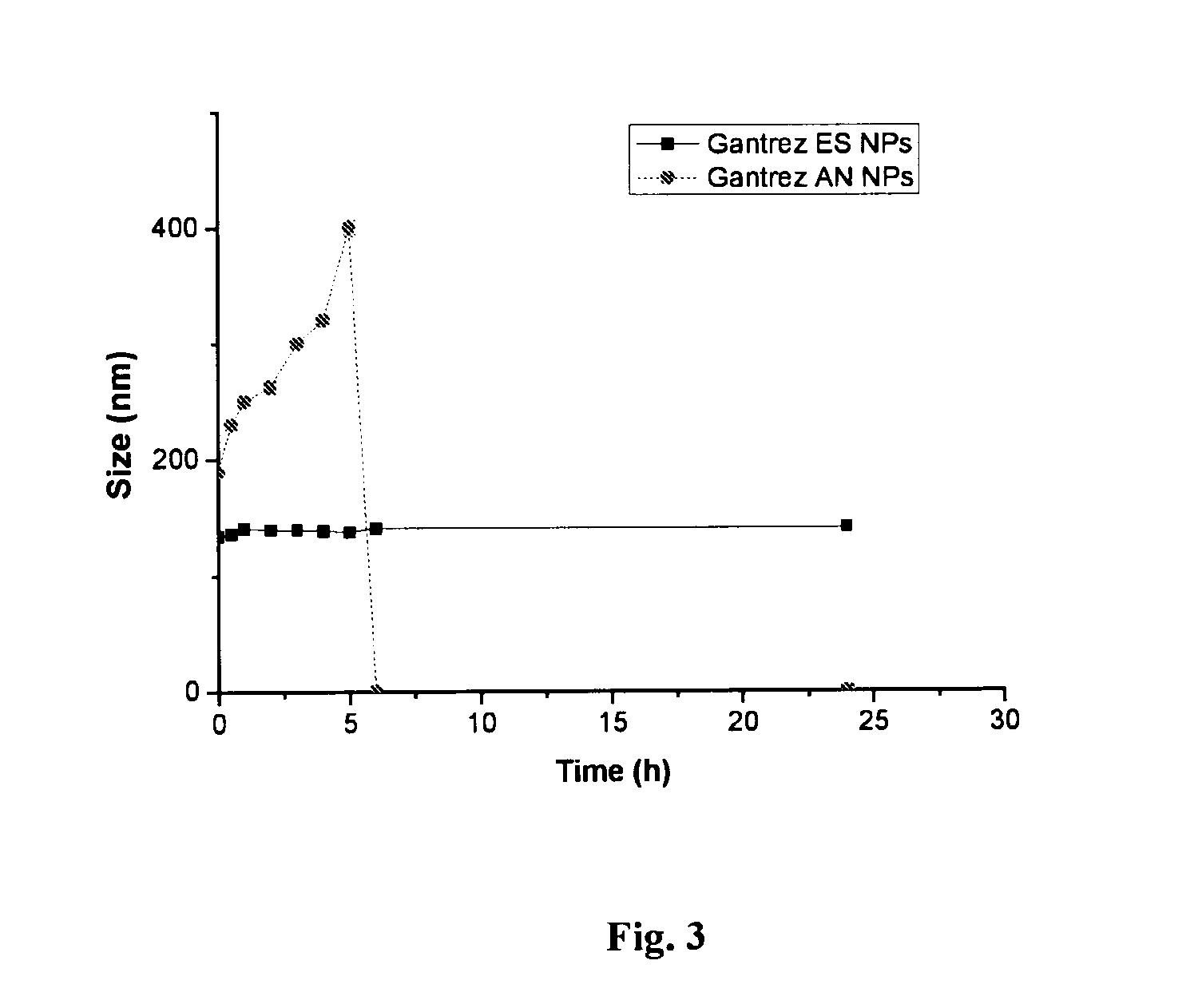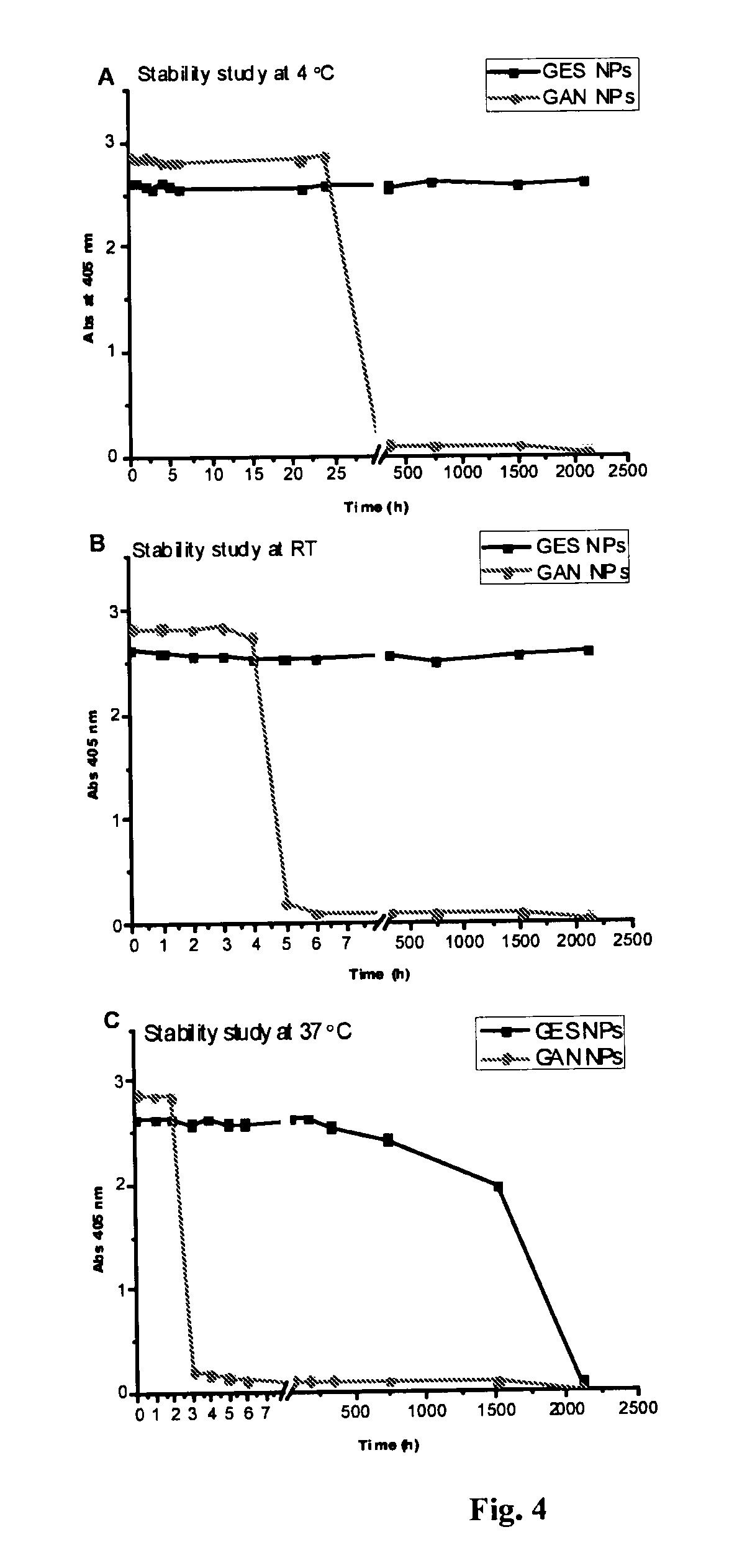Nanoparticles comprising esters of poly (methyl vinyl ether-co-maleic anhydride) and uses thereof
a technology of polymer and esters, which is applied in the field of biocompatible nanoparticulate delivery systems, can solve the problems of limited application of said microparticles, dramatic decrease of the bioadhesive capacity of nanosystems, and significant increase in the size of nanoparticles, and achieves high encapsulation efficiency
- Summary
- Abstract
- Description
- Claims
- Application Information
AI Technical Summary
Benefits of technology
Problems solved by technology
Method used
Image
Examples
example 1
Preparation and Characterization of GANTREZ® ES Nanoparticles
1.1 Preparation of GANTREZ® ES Nanoparticles by Nanoprecipitation-Solvent Displacement Method
[0195]To obtain GANTREZ® ES nanoparticles, the polymer ethanolic solution (50% w / v) of monoethyl ester (GANTREZ® ES 225) and monobutyl ester (GANTREZ® ES 425) of poly methyl ether-co-maleic anhydride copolymer (PVM / MA) was diluted with absolute ethanol to a concentration of 5% (w / v). Then, the nanoparticles were formed by mixing 5 mL of the polymer solution with 10 mL of bidistilled water as polymer miscible non-solvent. The resulting nanoparticles suspension was evaporated under reduced pressure using a rotavapor (Büchi R-144, Switzerland) to eliminate ethanol.
[0196]On the other hand, in situ self-assembled GANTREZ® ES nanoparticles (SANP) with low final content of ethanol without the need of evaporation were obtained. For this purpose, a non-volatile polyol (propylene glycol) polymer solution containing GANTREZ® ES 425 5% (w / v) w...
example 2
Preparation and Characterization of GANTREZ® ES Nanocapsules Containing Oils
2.1 Preparation of GANTREZ® ES Nanocapsules Containing Oils
[0209]In order to prepare GANTREZ® ES nanocapsules loaded with a liquid oil, lemon essential oil was incorporated into GANTREZ® ES polymeric shell by the solvent displacement method. For this purpose, 0.5 mL of lemon essential oil (fluorescently labelled with lipophilic fluorescent probe 1,1′-dioctadecyl-3,3,3′,3′-tetramethylindocarbocyanine perchlorate), and 0.5 mL of propylene glycol were mixed with 10 mL of a GANTREZ® ES 425 ethanolic solution having a polymer concentration of 25 mg / mL. After that, the oily polymer solution was poured into 30 mL of an aqueous phase (medium) containing a surfactant, namely TPGS (d-alpha tocopheryl polyethylene glycol 1000 succinate) at 1% (w / v). Control formulations were prepared by the addition of an lemon essential oil ethanolic solution without GANTREZ® ES 425 polymer. Then, the resulting nanocapsules suspension...
example 3
Preparation and Characterization of GANTREZ® ES Nanoparticles by Spray Drying
[0213]For this purpose, 50 mL of GANTREZ® ES 425 ethanolic solution (50 mg / mL) were mixed with 100 mL of distilled water to form GANTREZ® ES nanoparticles. Different surfactants were added to the nanoparticles hydroalcoholic suspension such as sodium dodecyl sulfate (SDS) (100 mg), PLURONIC® F68 [ethylene oxide / propylene oxide block copolymer] (100 mg) or TWEEN® 80 [polyoxyethylene (20) sorbitan monooleate] (7.5 mg). Finally, 7.5 g of mannitol were added as excipient. To obtain a dry powder of the GANTREZ® ES nanoparticles, the suspension was dried in a Mini Spray-dryer Büchi B191 (Büchi Labortechnik AG, Switzerland) under the following conditions:
[0214]inlet temperature: 90° C.,
[0215]outlet temperature: 60° C.,
[0216]spray-flow: 600 L / h, and
[0217]aspirator at 90% of the maximum capacity.
[0218]During the process the nanoparticles suspension was maintained under moderate agitation. The recovered powder was st...
PUM
| Property | Measurement | Unit |
|---|---|---|
| size | aaaaa | aaaaa |
| size | aaaaa | aaaaa |
| diameter | aaaaa | aaaaa |
Abstract
Description
Claims
Application Information
 Login to View More
Login to View More - R&D
- Intellectual Property
- Life Sciences
- Materials
- Tech Scout
- Unparalleled Data Quality
- Higher Quality Content
- 60% Fewer Hallucinations
Browse by: Latest US Patents, China's latest patents, Technical Efficacy Thesaurus, Application Domain, Technology Topic, Popular Technical Reports.
© 2025 PatSnap. All rights reserved.Legal|Privacy policy|Modern Slavery Act Transparency Statement|Sitemap|About US| Contact US: help@patsnap.com



